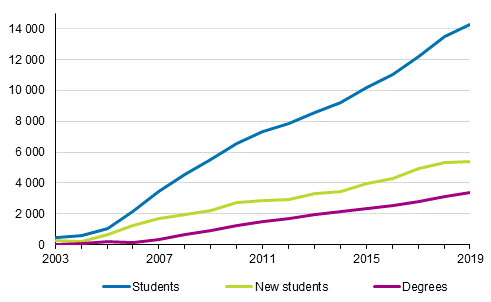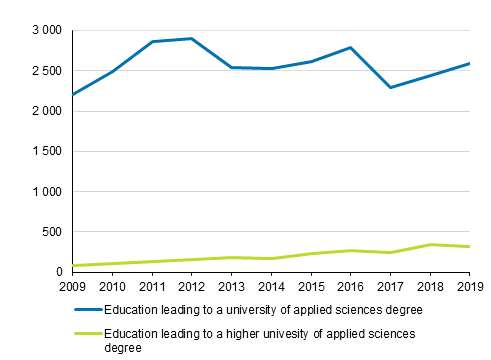This set of statistics has been discontinued.
Statistical data on this topic are published in connection with another set of statistics.
Data published after 5 April 2022 can be found on the renewed website.
Published: 17 April 2020
Participation in education leading to higher university of applied sciences degrees increased further
The number of students attending education leading to a higher university of applied sciences degree was good 14,000 in 2019, which is around 800 students more than one year earlier. The number of completed higher university of applied sciences degrees also increased, by good 200 degrees. On the other hand, the number of students in education leading to a university of applied sciences degree decreased compared to the previous year. In 2019, altogether close on 128,000 students attended education leading to a university of applied sciences degree. These data derive from Statistics Finland’s education statistics.
Students and degrees in education leading to a higher university of applied sciences degree in 2003 to 2019

Seven out of ten of completers of a higher university of applied sciences degree were women
Even though the number of students in education leading to a university of applied sciences degree decreased by around 650 from the previous year, the number of degrees remained on the same level, at close on 25,000 completed degrees.
Women attended education leading to a university of applied sciences degree more often than men in 2019. Altogether 52 per cent of those in education leading to a university of applied sciences degree were women, and almost two-thirds of those studying for a higher university of applied sciences degree were women. On the other hand, as many as 55 per cent of new university of applied sciences students were women, 67 per cent of those studying for a higher university of applied sciences degree.
Among those having completed a university of applied sciences degree in 2019, six out of ten were women. The corresponding share for higher university of applied sciences degrees was seven out of ten.
In education leading to a university of applied sciences degree the number of students was highest in the field of health and welfare, where close on one third, or 29 per cent, studied. Nearly one fourth (24%) studied in the field of technology and good one fifth in the field of business, administration and law.
The field of health and welfare was particularly popular among women, as many as 83 per cent of the students in the field were women in 2019. Correspondingly, men studied more in the fields of technology. In these fields, men’s share of students was 82 per cent.
Every third of those in education leading to a higher university of applied sciences degree studied in the field of health and welfare. Good one fourth studied in the field of business, administration and law and close on one fifth in the field of technology.
The number of students in education leading to a degree was highest at Helsinki Metropolia University of Applied Sciences, around 16,200 students. There were also over 10,000 students in Turku University of Applied Sciences and Haaga-Helia University of Applied Sciences. The smallest universities of applied sciences by the number of students were ┼land University of Applied Sciences (around 500 students) and the Police University College (good 1,100 students).
The highest number of university of applied sciences degrees was attained in 2019 at Helsinki Metropolia University of Applied Sciences, almost 2,800. Almost 1,800 degrees were also attained at Tampere University of Applied Sciences and Turku University of Applied Sciences. The clearly highest number, over 400, of higher university of applied sciences degrees were attained at Helsinki Metropolia University of Applied Sciences.
More foreign students than before come to universities of applied sciences
In 2019, more new foreign students than before attended universities of applied sciences. The number of students starting education leading to a university of applied sciences degree increased by around 200 to close on 2,600 in 2019 from the year before. On the other hand, the number of new foreign students starting education leading to a higher university of applied sciences degree fell slightly to 315 students from 2018.
The most common nationalities among new foreign students in education leading to a university of applied sciences degree were Vietnamese and Russian, over 300 of both started education. By contrast, the most common nationality among new foreign students in education leading to a higher university of applied sciences degree was Indian, good 30 of them started education. Slightly under 30 new students came from South Africa. Altogether, the share of new foreign students of all new students was 7.5 per cent in education leading to a university of applied sciences degree and around six per cent in education leading to a higher university of applied sciences degree.
New foreign students at universities of applied sciences in 2009 to 2019

More detailed time series data on university of applied sciences students and degrees according to education, sex and university of applied sciences, for example, are available in the database tables . More detailed data can be found on foreign students in the database tables of the statistics on Students and qualifications of educational institutions.
Source: Education. Statistics Finland
Inquiries: Timo Ruuskanen 029 551 3620, koulutustilastot@stat.fi
Director in charge: Jari Tarkoma
Publication in pdf-format (227.2 kB)
- Tables
-
Tables in databases
Pick the data you need into tables, view the data as graphs, or download the data for your use.
Appendix tables
Updated 17.4.2020
Official Statistics of Finland (OSF):
University of applied sciences education [e-publication].
ISSN=2489-3196. 2019. Helsinki: Statistics Finland [referred: 28.12.2025].
Access method: http://stat.fi/til/akop/2019/akop_2019_2020-04-17_tie_001_en.html

